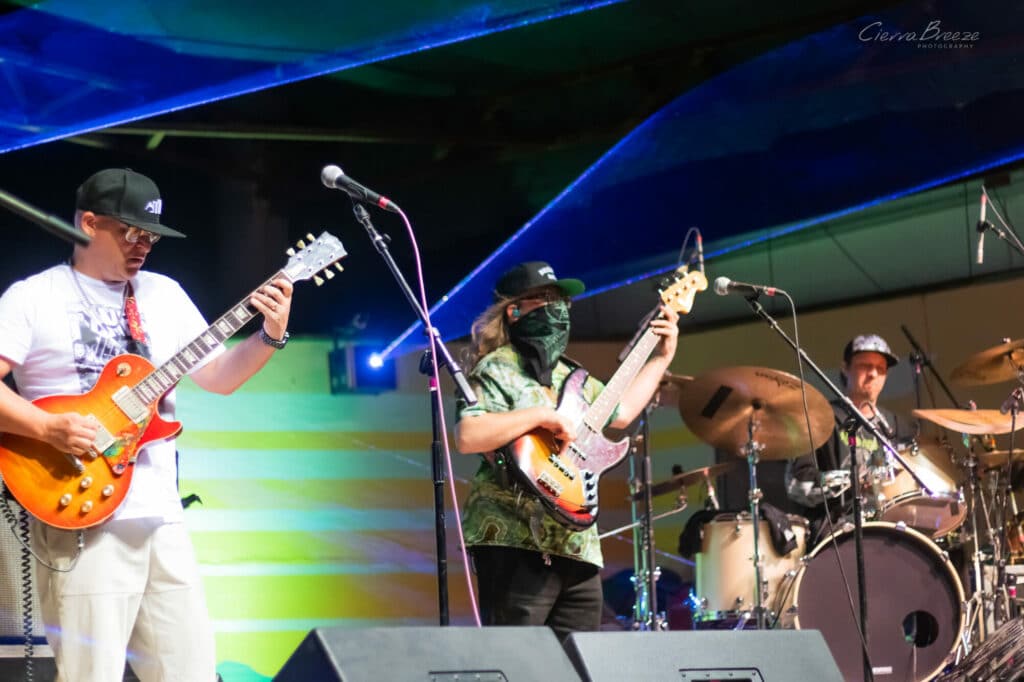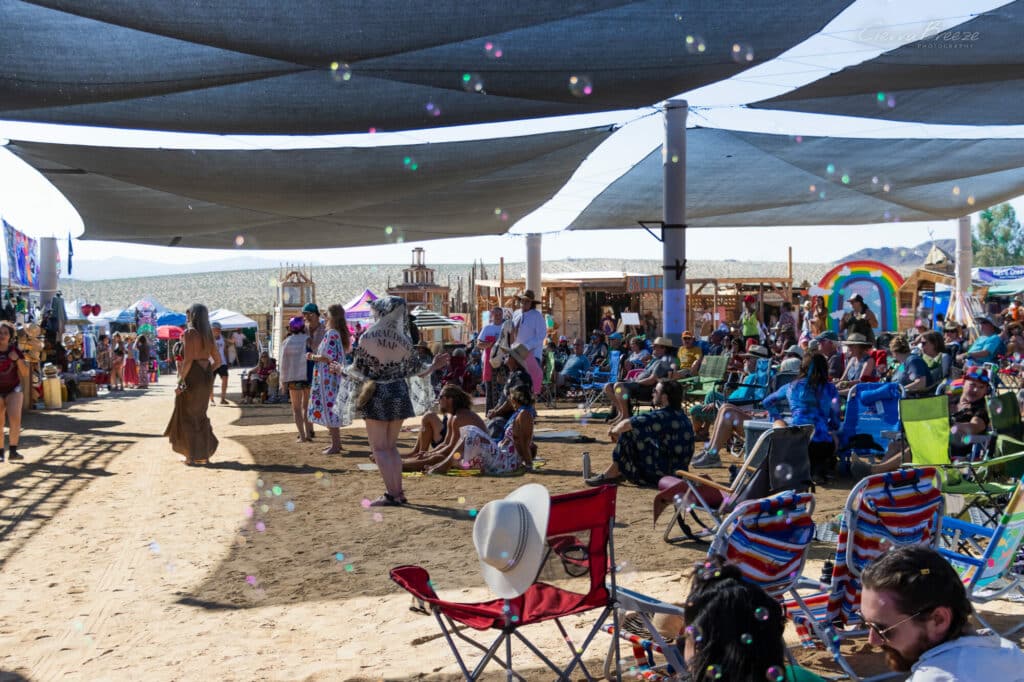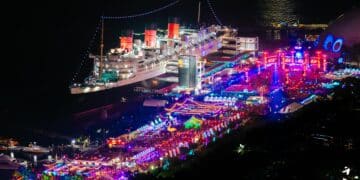Curation and creativity collide at Joshua Tree Music Festival, allowing families and freaks alike to experience freedom through music and movement.
For a winter creature like me, basking in the scorching sun at Joshua Tree Music Festival was quite challenging. The harsh days, however, were balanced by gorgeous nights filled with a wondrous atmosphere of music and smiles to nourish the soul. Never have I ever felt so safe and free at a music festival. The focus on family-friendly vibes and cleanliness really elevated Joshua Tree into a realm of greatness occupied by few other festivals I’ve attended.
Founded in 2003, Joshua Tree happens twice every year, once in May and once in October—with this fall’s variation taking place October 5-8. Situated in the majestic Mojave Desert at the precipice of Joshua Tree National Park, this sacred congregation of creativity carries an otherworldly quality. The motto of Joshua Tree Music Festival is “The Desert is Freedom, Music is Power, & Community is Crucial.” Living up to this ambition, all aspects of the festival are aligned to invigorate the barren landscape with abundance.
Filled with intention and diversity, the music schedule provided a heartbeat that animated the festivities with a pulsing aura of love matched by the weekend’s vendors and workshops. From the live electro-swing tactics of High Step Society to the funk-fueled jam band flair of Lettuce, Joshua Tree reverberated like a party with a purpose. Acts from all over the world graced the festival’s four stages, each showing admiration for Radical Love—the theme of this fall’s gathering.
Despite being sparsely packed with music (compared to other four-day events), the festival grounds served a hefty helping of styles and genres all weekend long. Sounds tended to emanate from one stage at a time, with artists bouncing back and forth between two main stages, one late-night dancefloor-centric stage and one side stage. To pull off this juggling act, the music curation was thoughtfully organized. Going in, I expected my attention to gravitate towards the sound of late-night DJs and electronic music. Instead, the bountiful blend of folk, hip-hop, and rock that abounded during peak hours dominated my Joshua Tree experience.

My first two days in the Joshua Tree desert started slowly with intention and reached a Friday crescendo with High Step Society’s soulful sonic shenanigans.
Thursday’s half-day was ideal for acclimating to the desert’s weather, elevation, and cactus-collecting crowd. The Joshua Trees were in full force, and all the people setting up camp were exceedingly neighborly. The music was a bit scattered, but this ended up being a good preview of the overall sonic variety to come. Novalima delighted my drum-hungry musical taste with their delicious take on Afro-Peruvian percussion underneath a whole host of influences, from electronica to dub to funk. Following, DJ Dragonfly conducted the party late into the night with a winding, hot, and sweaty set that culminated with Dirtwire‘s desert ballad “A Horse with No Name”—a fitting point to realize that I had finally arrived at my destination.
Friday turned up the temperature and tempo, but not before kicking off events with sunrise yoga and tea ceremonies at 7am. Joshua Tree devoted much time and effort to consciousness-uplifting spaces and activities, from the Sanctuary and Healing Oasis to the Positive Vibration Station and Astro Mojo Dojo Tea Lounge. Every workshop my group attended was insightful and engaging. On top of this, Kidsville and the Queer Salon ensured that all in attendance felt welcomed.
The two main areas of stages were shaded by giant structures that kept things cooler than your campsite, encouraging the masses to wander about during the daytime heat.
This organically increased the rate of new connections and promoted a positive communal mood that lasted the entirety of the gathering. The food vendors offered quality meals infused with flavors galore. The drink diversity was a bit lacking, but I have no complaints about any of the drinks I was served—strong coffee and strong alcohol. Similarly, no complaints can be made about the wide range of music on display.
Mak Nova & The Kings infused the Copper Mountain Stage with a royal rendition of hip-hop, R&B, and roots that was just as refreshing as the setting sun. As this performance wrapped up, the adjacent Indian Cove Stage began buzzing with anticipation for Lido Pimienta, who spent half of her set serenading the audience with ethereal singing and traditional Colombian songwriting. The other half? Well, it comprised the most badass raps and chants I’ve heard all year. Truly an unexpected dichotomy!
Then there was High Step Society, whose seven members performed an impromptu bus-top banjo set earlier that afternoon. Mixing a big band twang with jazzy vocals and electro-swing production, the headline High Step Society set was oozing with a level of energy impossible to ignore. The group’s repertoire of instruments blends swimmingly with the soulful singing above and the soulful electronic production below. The entire crowd, except for a pack of live painters, was movin’ and groovin’ until the very end when the main stages shut down, and the party was redirected to the late-night Boogaloo Stage. Here, the tunes kept spinning until the early hours of the morning—in both sound system and silent disco form.

Saturday was the peak of the festival, both in hot sunshine and fire music.
Early morning activities once again provided a grounding and alignment opportunity to set the day off right. However, I would have liked to see some of the midday events moved later into the night because the workshops happening around 3pm struggled with attendance, and the Positive Vibration Station (the home of yoga and movement) shut down at 6pm, just as the air cooled off.
But this scorching intensity didn’t stop people from overflowing the rhythmically sublime 5pm Yinyasa Flow and Sound Bath by OM in the Hills and DJ MDMX. Some other highlights that survived the heat were Apollo Bebop, a hip-hop/jazz quintet that quenched their audience with creative compositions and clever rhymes, and Madalisto, a two-man band from Malawi who shredded stringed instruments that I’ve never seen nor heard nor dreamed of.
Saturday’s main stages offered a much more focused span of music, sitting in the rock pocket for its climax.
Diggin’ Dirt had people stompin’ in the sand and adorning their shovels as dancing props. This was definitely the rowdiest the dance pit got all weekend. That is until Lettuce took the stage directly afterward. Unleashing one of the grooviest, funkiest jam band sets I’ve witnessed, Lettuce played to the crowd like the desert was all they’d ever known. And everybody in attendance picked up what they were laying down! The sound system was tuned for maximum jam band impact, excelling even with six or seven instruments hitting simultaneously.
Later that night, as my group was exploring the extent of the festival grounds and stargazing, we stumbled upon a bizarre sight: The dumpsters were alive with people sorting recycling and simultaneously getting down to a filthy DJ set with a live psychedelic funk band jamming atop. Everybody called it the dumpster set, and it perfectly encapsulated the spontaneity and serendipity running amok all weekend long.
The intensity dipped slightly on Sunday as the third straight day of mid-90-degree weather pounded the festival grounds. Nonetheless, people’s spirits were sky-high, and the music held onto its sense of levity.
TV Broken Third Eye Open epitomized this balloon-like experience of flying through the air in a weightless mood while slowly depressurizing from the previous night. The last song of their set featured an absolutely bellowing didgeridoo solo underneath guitar accompaniment and soulful vocals. This unique combination enraptured the dancefloor’s peripherals and made for one of the most remarkable moments all weekend. With a seamless transition into Kerala Dust, the main stages closed out Joshua Tree Music Festival with a resonance that harmonized with the collective four-day flow of the music schedule.

Ultimately, Joshua Tree welcomed this desert newbie with open arms and revealed a beautiful desert aesthetic that formed its identity as the weekend unfolded.
This is a festival that will challenge your biological self, so you must come prepared to withstand the desert’s harsh, arid elements. Additionally, you must be open to diverse music to get the most out of Joshua Tree. Many of the festival’s regulars buy tickets without a care in the world about the music lineup, so you always get a dose of different frequency flavors.
With a folksy focus on jammin’ band music and a happy-go-lucky attitude, this festival won’t excite everyone. Although, it will welcome everyone with open arms. The true magic of Joshua Tree lies in its family-friendly equilibrium that delivers a fun and safe place for people of all ages, cultural backgrounds, and gender identities, whether you’re sober or not. This diversity was especially evident in the music lineup, which surprised me from beginning to end with a striking array of instruments, languages, and powerful feminine voices.
As someone who typically seeks out provocative festival experiences that push the dynamic front edge of sonic experimentation, Joshua Tree was way out of my comfort zone. By the end of the festival, however, my comfort zone had seamlessly shifted to bask in the love and light cultivated by four days of unadulterated positivity. Going in, my main aim was merely to survive. By the end, my spirit was in a state of thriving. Joshua Tree Music Festival is definitely worth checking out, so if the desert ever summons you, swing by for four days of radical love, marvelous music, and friendly faces.







